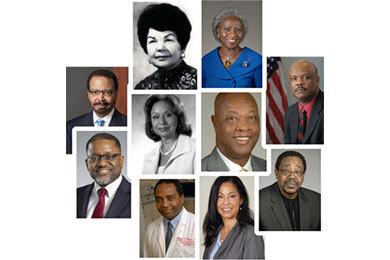
Credit: NIH, NHLBI, NIDDK, NIMHD, NLM, ORWH, and Blackpast.org
Black History Month (also known as African American History Month) is an opportunity to look at past accomplishments. The NIH has been a leader in supporting science and technology, with that mission fostered by several prominent African American/Black trailblazers. Just within the 21st century, we have benefited from the leadership of Drs. Janine Clayton, William Coleman, Jr., Gary Gibbons, Alfred Johnson, Roderick Pettigrew, Vivian Pinn, Griffin Rodgers, John Ruffin, and Hannah Valantine. In addition to these readily-identifiable leaders, we also benefited from the efforts of historical luminaries who may not be as recognizable (a concept you may recall if you’ve seen the movie Hidden Figures). Today, we bring your attention to a 20th century NIH leader whose pioneering thought led to a significant expansion of NIH-funded career opportunities for underrepresented scientists pursuing biomedical careers: Dr. Geraldine Woods.
The Legacy of Dr. Geraldine Woods
The history of enhancing diversity at the NIH really began with Dr. Woods, who in 1945 earned her Ph.D. in neuro-embryology from Harvard University. Through her persistence, Dr. Woods found a receptive atmosphere at the National Institute of General Medical Sciences (NIGMS), where she made her way to that IC’s Advisory Council in 1964. By 1970, Dr. Woods had presented her findings from years of work, including notes from traveling around the country, which detailed a plan for developing research and training programs targeted at Historically Black Colleges and Universities (HBCUs). As a result, the NIH established and funded two landmark programs in 1972: the Minority Biomedical Research Support program (MBRS), and the Minority Access to Research Careers program (MARC).
More on the MARC Program
Today, the NIGMS MARC program has a new name (Maximizing Access to Research Careers) but its spirit—to enhance diversity within the scientific workforce—remains the same. In its current form, it is an undergraduate student training program designed to enhance diversity at institutions with research-intensive environments. The program provides institutional awards to support academic, research, and professional development activities for undergraduate students from groups underrepresented in the biomedical sciences. MARC trainees have the opportunity to participate in a variety of training activities, which include conducting biomedical research in a laboratory setting, and engaging in educational initiatives about various science careers. MARC students are provided an annual stipend and partial tuition and fees.
A 2016 study evaluated how well the MARC program met its goal of enhancing the diversity of biomedical scientists. This report included MARC alumni appointed from 1986 to 2013, which encompassed over 9,000 students, at 114 institutions. Among the educational outcomes measured, two striking observations stand out:
- Approximately 70% of recent MARC alumni have enrolled in a science or health graduate program. This is one of MARC’s primary goals.
- 29% of recent alumni have earned a Ph.D. or M.D./Ph.D. This rate is almost twice that seen for undergraduates supported by other NIGMS initiatives to enhance diversity, and almost four times higher than biology undergraduates in general.
Overall, findings from the 2016 study provided strong support that the MARC program is meeting its educational goals.
Highlighting Alums from MBRS and MARC
Measuring educational outcomes has clearly shown the MARC program’s success with undergraduates. Additional goals of the program that are focused on developing earlier stages of the scientific workforce career pathway (i.e., pre-college) may foster a larger pool of MARC-eligible undergraduates, further magnifying its potential impact.
However impressive statistics and objective measures can be, it is also useful to look at a more personal level. As such, I want to take the opportunity this month to highlight a couple of alums from the MARC and MBRS initiatives. (Note: the early efforts of MBRS continue today through programs such as RISE for undergraduate students, IMSD for graduate students, and SCORE for faculty members—all under the NIGMS research training umbrella.)

Source: NIH NIGMS
Omolola Eniola-Adefeso was a MARC student at the University of Maryland, Baltimore County, where she graduated with a B.S.E. in chemical engineering. She then earned a Ph.D. in chemical engineering at the University of Pennsylvania in 2004. Following two years as an NIH postdoctoral fellow at Baylor College of Medicine, Dr. Eniola-Adefeso is now an associate professor of chemical engineering at the University of Michigan. Her research focuses on cellular inflammatory response and blood flow dynamics to design bio-functionalized particles for targeted drug delivery and imaging.

Source: NIH NIGMS
Andrew Campbell was an MBRS program participant at the City University of New York, York College, where he graduated with a B.S. in biology. He then earned a Ph.D. in molecular biology at the University of California, Los Angeles in 1987. Dr. Campbell is now dean of the graduate school and a professor of medical science at Brown University. His research focuses on microbial diseases, particularly infectious diseases in neglected populations and regions.
Parting Thoughts
The lasting legacies of NIH’s African American and Black scientific figures, including the established leaders initially mentioned, have made an enduring impact on the diversity of the scientific workforce. Their leadership has not only spanned various offices, institutes, and initiatives, but their achievements will continue to shine a guiding light for the generations of researchers that succeed them.
Given the changing demographics of our country, there are now more opportunities than ever for enhancing the scientific workforce career pathway. How successful the future efforts are may rest on how well we learn from the past examples set by leaders like Dr. Geraldine Woods.

